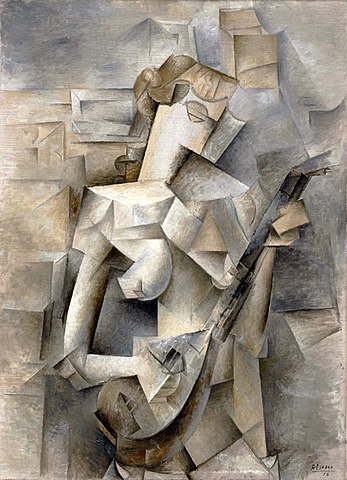
By Pablo Picasso – wordpress, PD-US, https://en.wikipedia.org/w/index.php?curid=38782663
What is cubism? Cubism is an art form where the artist tries to show an object from multiple viewpoints at the same time.
Pablo Picasso is credited with inventing cubism in about 1907, but he wasn’t the only artist experimenting with shapes, he was only the most well-known of them. These artists didn’t intend to come up with a new style of art and Picasso didn’t come up with the expression. “Cubism” was coined by journalists in 1911 and they didn’t mean it positively. They wanted a word to describe the geometric shapes that five artists had used in their paintings, displayed in a Paris exhibition. They had possibly picked up on the word “cube” because the famous art critic Louis Vauxcelles had used it several times to describe the emerging style.
Art has evolved over thousands of years and will continue to evolve. Traditional artists, meaning artists of the renaissance, would attempt to paint something as though it were being viewed by the viewer, at that time in space. They would use light, perspective, and shading to show us the image as realistically as possible. Our eyes can only focus on any one part of the picture at once and this would create a hierarchy within the picture. Some things would draw the viewer’s attention more than other things. Cubists tried to do away with this traditional form and tried to show every side of an object at once. They wanted to display space, mass, time, and volume on a 2D canvas. They wanted to show past, present, and future as one constant thing, showing that we experience life as a conscious flow and not as separate and individual events or points.
Cubism came about because artists were trying to work out how to portray the complexity of life on a canvas. Life doesn’t sit still and only show you one side. You can look all around an object and it changes as the light moves and as time flows by. Artists wanted to show this, but they didn’t know how. One idea that emerged was to break down the object into simple geometric shapes. Everything in the world, no matter how complicated, can be broken down into simple shapes. This evolved into cubism.
There were three stages of cubism. The first stage was proto-cubism. This lasted from approximately 1906 to 1910 and was the experimental phase where the artists moved away from complex images and moved towards simplified shapes and colors. They didn’t use shading and used very simple colors. By simplifying the object, they were trying to show how complicated it was.
The second phase was known as analytic cubism. This continued the developments of proto-cubism and lasted until about 1912. They continued trying to show multiple perspectives at one time. They wanted to represent every part of the image as equal, with no one point being more valued than any other.
The third phase was called synthetic cubism. This started when artists began to add bits of newspaper and other things they found lying around into their work. The words on the things used would be combined into the picture and used for their meaning. The juxtaposition between the high art of the painting itself and the low art of the advertising or whatever artifact they had added, would give the painting more meaning.
Cubism was not only a style of painting. Picasso created a few cubist sculptures. His most famous is called “Head of a Woman” and is a woman’s head, but with ridges and shapes raised out of it. Picasso was trying to show her from every perspective at once.
The cubist movement was interrupted by World War 1, and it never really regained its momentum after that. Picasso and the other artists continued to experiment, and cubism slowly evolved into many other different art movements. Louis Vauxcelles tried to argue that cubism was dead after the First World War, but there was a small revival that lasted until about 1924.
So, what is cubism? It is an attempt to show a 3D image on a 2D canvas. The artists wanted to show every part of the image at the same time and make every part the equal of every other part. And this is what I learned today.
Sources
https://useum.org/Cubism/What-is-Cubism
https://en.wikipedia.org/wiki/Cubism
https://www.studiobinder.com/blog/what-is-positive-and-negative-space-in-art/
https://en.wikipedia.org/wiki/Proto-Cubism
https://www.tate.org.uk/art/art-terms/cubism
https://www.ideelart.com/magazine/what-is-cubism-art
https://www.moma.org/collection/works/82049
